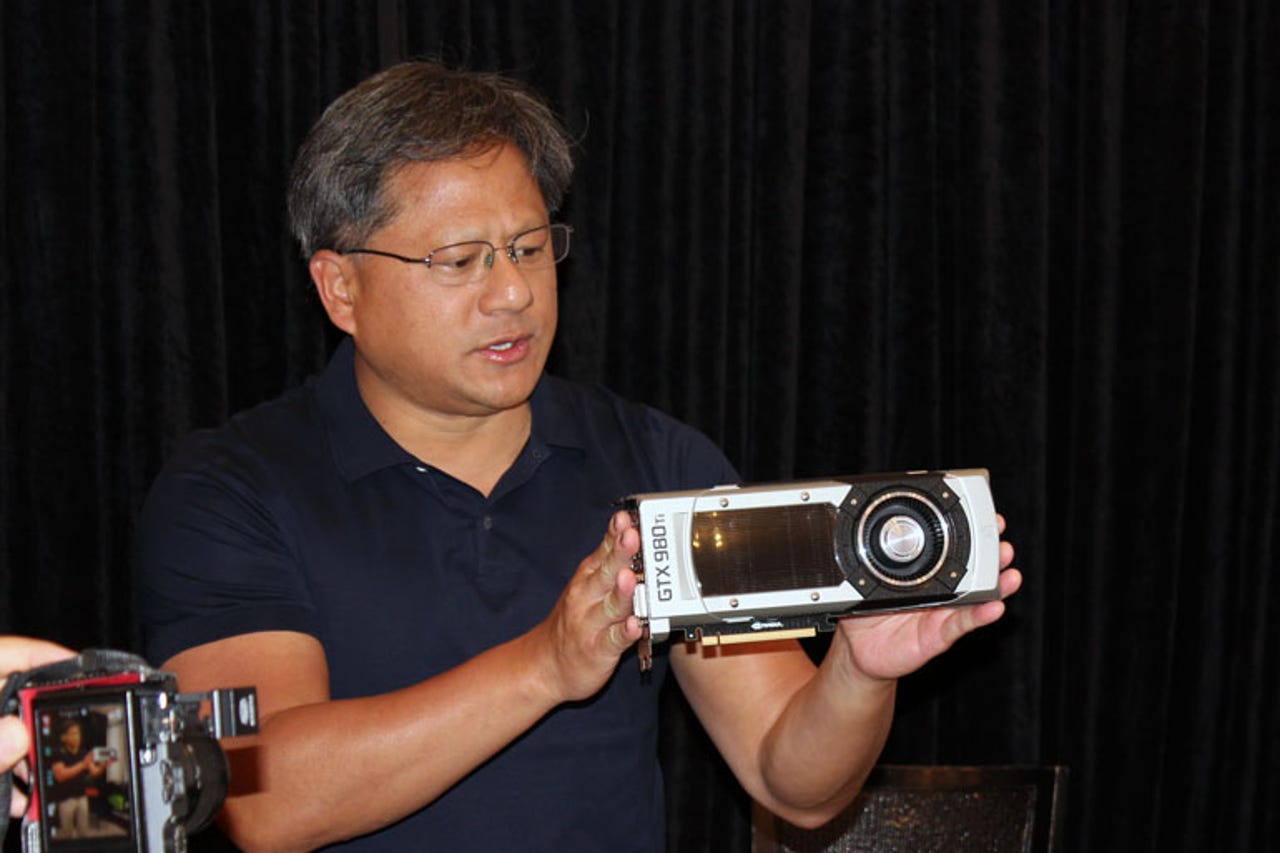Computex 2015: Nvidia talks GeForce GTX 980 Ti, Android gaming and self-driving cars


Chipmaker Nvidia got a jump on Computex announcing its latest high-end graphic processor before the start of the show this week. CEO Jen-Hsun Huang briefed the media earlier today in Taipei on the new GPU and other bets including the Shield Android TV and Drive PX platform for self-driving cars.
The GeForce GTX 980 Ti uses the same Maxwell GPU, known internally as the GM200, as the company's $1,000 Titan X. That means it delivers high performance, but is "quiet and cool" with no need for liquid cooling, Huang joked. (This week rival AMD is expected to introduce a new high-end GPU, most likely the Radeon R9 390X, which will reportedly rely on liquid cooling.)
In comparison to Titan X, the 980 Ti has fewer shaders (22 versus 24) and only half the memory at 6GB. But that is still plenty of power, and Huang said that the 980 Ti was designed specifically to drive 4K gaming at "really good frame rates," noting that prices for Ultra HD monitors and TVs drop rapidly. It also has comprehensive support for the DirectX 12 application programming interface just in time for the release of Windows 10 this summer.
Finally it is designed to deliver a better experience with virtual reality (VR) headsets like Oculus Rift with a feature called Multi-Resolution Shading. VR headsets warp the edges of an image so that it looks correct close to the eye. Multi-Resolution Shading renders the center of the image at full resolution, but draws the edges at lower quality since much of it is thrown out anyway. Since the GPU isn't working as hard, it can deliver 20-30 percent better performance on VR, Huang said.
Computex 2017
While the Titan X is targeted primarily at game developers and researchers working on deep learning that need 12GB of memory, the 980 Ti is meant to reach a broader audience at $650. Huang said that there are some 100-200 million GeForce gamers worldwide-many of them using the older GeForce GTX 680 and GTX 780/780 Ti and due for upgrades.
Although Nvidia continues to rely on the same 28nm process technology, it has been able to improve performance through improvements to the system architecture at a faster rate than Moore's Law, Huang said. The company says the 980 Ti delivers three times the performance of the Kepler-based GTX 680. Despite this Huang said he still expects new process technology to deliver benefits for companies like Nvidia that need the best possible performance even as the cost of designing and manufacturing leading-edge chips escalates. "I'm still enthusiastic about the new process technology," he said.
The introduction of a new type of stacked memory, known as High-Bandwidth Memory (HBM), is also expected to boost performance. AMD has already said it will be the first to introduce it and the GPUs it will announce later this week at Computex will use up to 4GB (four 1GB stacks). Huang said that for now HBM is too expensive and in limited availability, but "in the next year or so we'll be able to take advantage of that technology." Nvidia's next-generation Pascal GPU will most likely be manufactured on a 16nm FinFET process with up to 32GB of HBM2.
Nvidia also talked about its focus on Android as a gaming platform. The company has given up on smartphones and recently exited the modem business. "I think phones are largely done," he said. "It is a commodity, and there are many strong players there already." But Huang said that Android is much broader than that--it is an open, Internet operating system with billions of users. Nvidia's latest attempt to crack that market is the Shield Android TV formally launched during the Google I/O conference last week. Based on the Tegra X1 processor, the Shield comes with 16MB for $200 or a 500GB hard drive for $300, and doubles as both an over-the-top streaming device capable of 4K video and a game console that can play downloaded games or stream 1080p games using Nvidia's GRID service. "We think this is the future of television," Huang said.
Finally, Huang talked about the company's progress on automotive. In particular, he emphasized the company's Drive PX module for self-driving cars. The board uses two Tegra X1 processors to deliver 2.3 teraflops of processing as well a 12 camera inputs to power a deep learning system that can recognize lanes, cars and objects. The Drive PX board is now shipping to developers, researchers and car companies, Huang said. The other half of Nvidia's automotive platform is Drive CX for digital cockpits and infotainment systems.